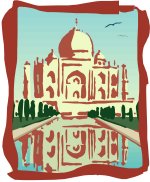
Worksheets and No Prep Teaching Resources
Reading Comprehension Worksheets
Ancient India

Ancient India
 Worksheets and No Prep Teaching Resources Reading Comprehension Worksheets Ancient India |
 Ancient India |
| edHelper's suggested reading level: | grades 8 to 10 | |
| Flesch-Kincaid grade level: | 8.39 |
|
The Mughal Dynasty
By Vickie Chao |

|
 1 The year of 1526 was a defining time in the long history of India. In that year, Babur, a Turkish prince, launched a series of attacks against India from his base in present-day Kabul, Afghanistan. In the showdown at Panipat, his troops collided with Sultan Ibrahim Lodi's men. As the two sides met head-on, the sultan was confident that the victory would belong to him. After all, he had nearly 100,000 men and 100 elephants in his camp! Things, however, did not go as planned. While Babur commanded only 12,000 men and had no elephants, he had a better army and the latest weaponry (cannons) at his disposal. Thus, he won the famous battle of Panipat. After the victory, Babur killed the sultan and captured his capital city of Delhi. He then went on to subdue the city of Agra. Babur chose that city to be the new capital city of his empire. He proclaimed himself the first ruler of the Mughal (also spelled as Mogul) dynasty.
1 The year of 1526 was a defining time in the long history of India. In that year, Babur, a Turkish prince, launched a series of attacks against India from his base in present-day Kabul, Afghanistan. In the showdown at Panipat, his troops collided with Sultan Ibrahim Lodi's men. As the two sides met head-on, the sultan was confident that the victory would belong to him. After all, he had nearly 100,000 men and 100 elephants in his camp! Things, however, did not go as planned. While Babur commanded only 12,000 men and had no elephants, he had a better army and the latest weaponry (cannons) at his disposal. Thus, he won the famous battle of Panipat. After the victory, Babur killed the sultan and captured his capital city of Delhi. He then went on to subdue the city of Agra. Babur chose that city to be the new capital city of his empire. He proclaimed himself the first ruler of the Mughal (also spelled as Mogul) dynasty. |
Create Weekly Reading Books
Prepare for an entire week at once! |
| Leave your feedback on The Mughal Dynasty (use this link if you found an error in the story) |
 |
Ancient India
|
 |
High School Reading Comprehensions and High School Reading Lessons
|
 |
Social Studies
|